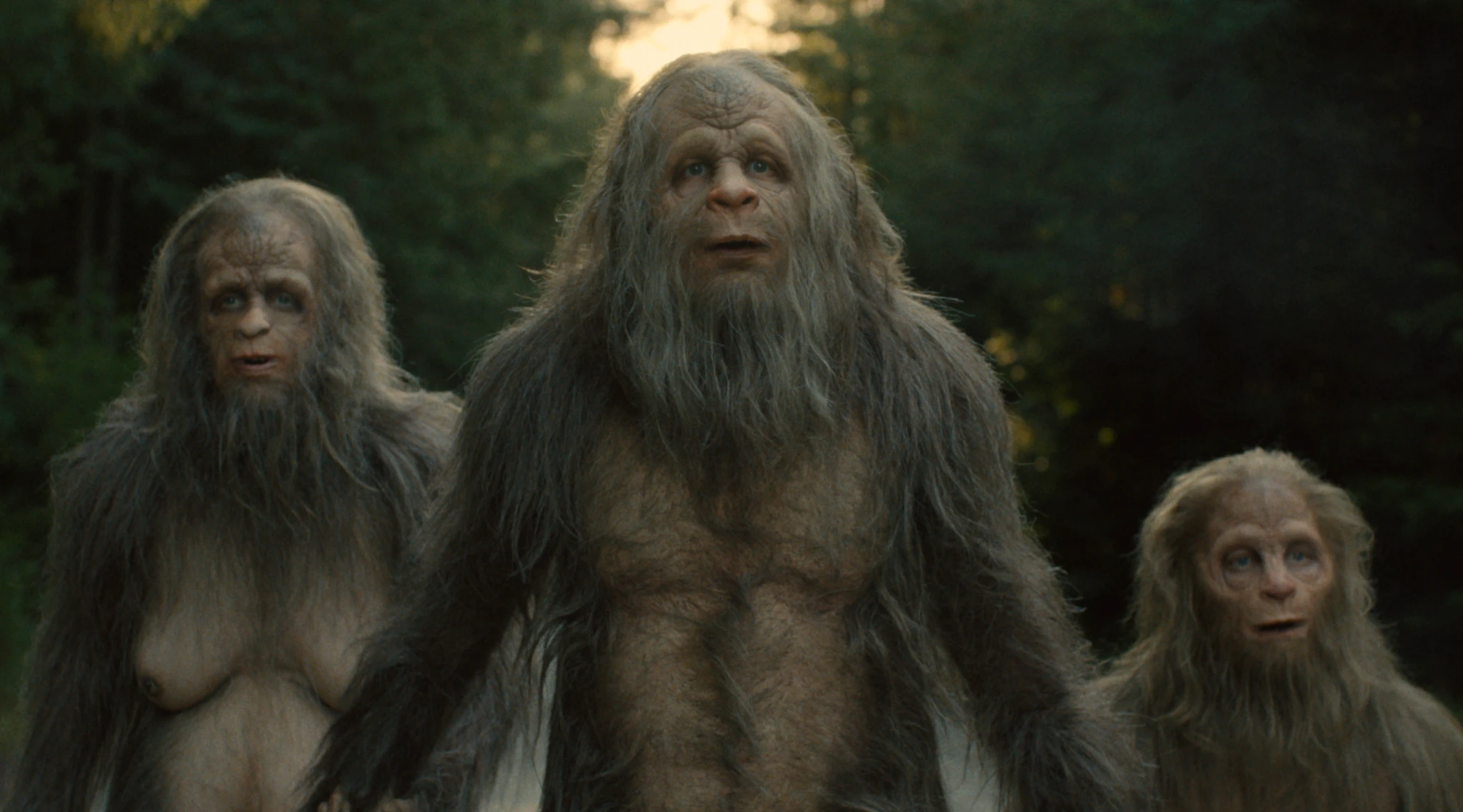"We've always loved Bigfoot, ever since we were kids," says David Zellner, one half of the filmmaking duo the Zellner Brothers. "One day, I think we just started joking about how the only footage that's ever 'captured' of Bigfoot is just of it walking around. We were like, 'Well, it's got to do more than that...'"
David and Nathan Zellner's lifelong obsession first begat their 2010 short film Sasquatch Birth Journal 2 and now, more than a decade later, a feature film: Sasquatch Sunset, an oddball yet surprisingly earnest comedy about a family of Sasquatch over the course of one year living in the Pacific Northwest. Like their past directorial efforts, 2014's Kumiko, the Treasure Hunter and 2018's Damsel, the movie is singular creative vision that plays by its own absurdist rules.
It was, however, not an easy vision to get others onboard with.
"It was a hard film to pitch, because there's not an easy comp for it," David explains. "When people think about Sasquatch movies, their go-tos are usually either horror or spoof movies, neither of which this is." The film strives to treat its Sasquatch characters with as much respect as possible — even as they engage in the most ludicrous, primitive behavior. "Getting Ari Aster and his production company, Square Peg, involved helped move it along."
Another major breakthrough came when Jesse Eisenberg, a longtime friend of the Zellners, signed on to both star in the film and serve as one of its producers. "That really gave it some legitimacy," David says. "The film wouldn't have happened without Jesse."
It was Square Peg who connected the Zellners with visual effects artist Steve Newburn, who previously worked on Aster's Beau Is Afraid and was tapped to transform Eisenberg and co-stars Riley Keough, Christophe Zajac-Denek and Nathan Zellner into Sasquatch. "For years, I thought, 'God, if I ever got a chance to design a Sasquatch of my own,'" Newburn tells A.frame, "'that would be my dream job.'"
In conversation with A.frame, the filmmaking team reflects on the journey of making Sasquatch Sunset.

For David and Nathan Zellner, 'Sasquatch Sunset' is the product of a shared obsession that began when they first saw the the infamous Patterson-Gimlin film as young boys. For the latter brother, it was never a question whether he would play one of the Bigfoot, too.
David Zellner: For the record, Nathan wanted to be a Sasquatch.
Nathan Zellner: I did! I've got a good build to play a Sasquatch. I've done it three other times before actually. This is my fourth time playing Bigfoot. [Laughs] I was really excited to get into this level of makeup and disappear beneath the weight of the costume and prosthetics and everything.
As for everyone else, Jesse is a good friend, but we'd never had the opportunity to work with him before. David wrote the script and slipped it to him just out of curiosity, and Jesse read it and right away was like, "I have to be in this movie. I have to have this experience." He caught the same obsession we had. With Riley, we talked to her a couple of times before we actually sent her the script, but she read it and instantly fell in love with it as well. We knew that she, like Jesse, is really good at doing both comedy and drama. We like to tread between those two territories in our films, and she's really fearless and has a great sense of humor. Her comedic timing is amazing, and we got to see her flex that muscle in this film. You'd think that making something like this would be hard, but not when the right pieces fall into place. It was amazingly easy to get our actors excited for it, because we found the right people at the right time.
The movie was a chance to pay homage to the creature features that the brothers loved throughout their childhood and the practical effects that so inspired them. They would soon discover that Steve Newburn shared that same passion.
Nathan Zellner: We grew up as true VHS kids. At a young age, we were really into classic creature movies and effects. Some of those legendary makeup and costume artists, like Rick Baker and Rob Bottin, were our heroes when we were younger. So, we've always wanted to do something like Sasquatch Sunset at a scale that was big enough for it... We started getting everything we needed piece by piece, which included getting Steve to sign on. He loved the challenge of designing creatures that were going to be front and center of every frame of a movie, which isn't the norm. It's the ultimate challenge for someone in his line of work.
Steve Newburn: I was told, "It's a Sasquatch movie," and I was like, "Oh my God! That's the bucket list creature that I haven't gotten to do yet!" They said, "It's very independent. It's gonna be low-budget," and I told them, "I don't care. I want to do this. We'll figure it out and make it happen.'" In this era where so many effects are computer-based, it was really nice to see a practical approach to things again. I think if David and Nathan had done it with a bunch of CG Sasquatch running around, even if they had $100 million, it wouldn't have worked, because the characters' humanity would have gotten lost.

Despite a tight budget, both the Zellners and Newburn had grand ambitious for the designs of their Sasquatch. Each of the four characters needed a custom bodysuit as well as extensive prosthetics; however, the layers of makeup could never get in the way of the soul of the Bigfoot.
David Zellner: It's a movie from the point of view of the creatures, so we're approaching it with a sincerity, earnestness, and reverence for them. We wanted to shoot it in a way that — for the most part — legitimizes them. here are plenty of Bigfoot movies that are either family films or horror movies, but almost all of them are from the perspectives of humans discovering these outsider, alien creatures. The Sasquatch are usually presented as Boogeyman-type figures. We wanted to put them front and center and tell a story through their point of view by thinking about their interior lives and their sense of logic. We wanted to find a way to connect with them through their most human qualities.
Steve Newburn: David and Nathan's original lookbook had sketches of things that were pulled off the internet that inspired them. I had my own ideas that I'd been thinking about for years already, too, but I realized we were just on the same page from the start. I knew, for instance, that we'd need to maintain the actors' eyes and not put contact lenses on them, because their eyes were going to be really important to selling the film's emotions.
Nathan Zellner aside, the rest of the cast had never experienced the sort of complete transformation that 'Sasquatch Sunset' demanded of them — which wasn't just a matter of makeup and costuming. The Zellners assembled their cast prior to filming and hosted an "ape camp," as they now refer to it.
Nathan Zellner: I think it was helpful to the actors that I had a little bit of a head start because I'd lived with the project for so long, and so had David. When he was writing it, we'd joke around about different Sasquatch mannerisms and things like that, and that was important when we then all worked with Lorin Eric Salm, the movement coach that Jesse brought in. Then, when we did our rehearsals and movement training, we were trying to figure out a new species together, but the main thing was making sure everyone felt comfortable with each other, because it's ultimately a film about a family. You really have to feel when you're watching it that the characters have a connection with each other that doesn't just come from being of the same species. They have to feel like a family.
Steve Newburn: Ultimately, I think there's something very human about the film's characters, and that's due to the actors' performances. Most of the time, it's creature performers and stunt people who end up in movies like this, and I'll admit that I was nervous when we started, because I knew that none of them had ever done anything like this before. I didn't know how it was going to go. I even asked Riley the first time we met, "What made you want to do this movie?" She said, "It's not something I've ever done before!" At first, I thought, "Oh, she has no idea what she's getting into," but she's so fantastic in the movie!
Nathan Zellner: Once we had the technical aspects of what it meant and looked like to be a Sasquatch in the movie figured out, making it was just like it is with any film. A lot of what happened on set was us talking about motivation and character the same way you normally would, so even though we were in suits and I was spending half my time behind the camera dressed like a Sasquatch, it all began to seem normal pretty quickly.

'Sasquatch Sunset' demanded that the entire creative team go out on a figurative limb together. During this year's Sundance Film Festival, the Zellners unveiled what can only be described as the culmination of their life's work. At the very least, they have finally made the Bigfoot movie of their dreams.
David Zellner: The films we make choose us. It's what we're the most obsessed about, because these things are so hard to make, and there's no way to do something we're not passionate about. It wouldn't be worth anyone's time and too much heartache. Some ideas percolate for a while, and then you lose interest or they run their course, and then the ones that stick around and keep screaming at you until you make them, you follow through with that. This is one that we couldn't shake. And the more we dove in, the more obsessed we got, and then little by little, you get other people joining you that share that obsession, and step by step, it finally pulls it together.
Steve Newburn: I've seen the movie three times now, and the first time I was just watching for every little flaw. Overall, though, I was taken aback a bit by it, because I was like, "Wow. This whole thing worked!" We did it, thank God. And I'm just so happy to have had the opportunity. I didn't overthink it or feel the need to worry whether the work we'd done was going to get replaced in post-production or not. The challenge this time was forgetting about the small amount of time and money we had. We tried to make the best film that we could, because we knew we were never going to get to do anything like it again.
By Alex Welch
RELATED CONTENT:
Inside Jesse Eisenberg and Riley Keough's 'Sasquatch Sunset' Transformations (Exclusive)







